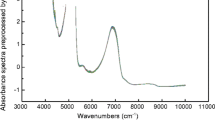Abstract
Fifteen micro-fermentation trials were conducted during the 2008 vintage harvest in the Valtellina (Northern Italy) viticultural area. During fermentation, the spectra were achieved in the near and mid-infrared region by a FT-NIR spectrometer and a FT-IR spectrometer, respectively. Samples were also analysed by using chemical methods to evaluate sugars (glucose and fructose), alcohols (ethanol and glycerol) and phenolic compounds (total phenolics, total anthocyanins and total flavonoids). The pretreated spectral data were processed using principal component analysis. After feature selection by the algorithm SELECT, linear discriminant analysis (LDA) was applied to spectral data as a classification technique, to predict the fermentation stage from initial to final phase. Moreover, partial least square regression was used to predict sugar content, ethanol, glycerol and phenolic compounds simultaneously. LDA results, characterised by a high percentage of correct classification (87% and 100% as average value in prediction for NIR and MIR spectroscopy, respectively), showed that samples belonging to a particular fermentation step could be correctly classified. Good calibration models for the prediction of the main compositional changes during alcoholic fermentation were obtained with both FT-NIR and FT-IR, suggesting that either instruments could be used to evaluate online and simultaneously these compounds in red wine.




Similar content being viewed by others
References
Cen H, He Y (2007) Theory and application of near infrared reflectance spectroscopy in determination of food quality. Trends Food Sci Tech 18:72–83
Fagan CC, O’Donnell CP (2008) In: Irudayaraj J, Reh C (eds) Nondestructive testing of food quality. Blackwell Publishing, Ames
Woodcock T, Downey G, O’Donnell CP (2008) Better quality food and beverages: the role of near infrared spectroscopy. J Near Infrared Spectrosc 16:1–29
Schuster KC, Mertens F, Gapes JR (1999) FTIR spectroscopy applied to bacterial cells as a novel method for monitoring complex biotechnological processes. Vib Spectrosc 19:467–477
Sivakesava S, Irudayaraj J, Ali D (2001) Simultaneous determination of multiple components in lactic acid fermentation using FT-MIR, NIR, and FT-Raman spectroscopic techniques. Process Biochem 37:371–378
Finn B, Harvey LM, McNeil B (2006) Near-infrared spectroscopic monitoring of biomass, glucose, ethanol and protein content in a high cell density baker’s yeast fed-batch bioprocess. Yeast 23:507–517
Roychoudhury P, Harvey LM, McNeil B (2006) Review. The potential of mid infrared spectroscopy (MIRS) for real time bioprocess monitoring. Anal Chim Acta 571:159–166
Roychoudhury P, O’Kennedy R, McNeil B, Harvey LM (2007) Multiplexing fibre optic near infrared (NIR) spectroscopy as an emerging technology to monitor industrial bioprocesses. Anal Chim Acta 590:110–117
Cozzolino D, Kwiatkowski MJ, Parker M, Cynkar WU, Dambergs RG, Gishen M, Herderich MJ (2004) Prediction of phenolic compounds in red wine fermentations by visible and near infrared spectroscopy. Anal Chim Acta 513:73–80
Urbano-Cuadrado M, Luque de Castro MD, Pérez-Juan PM, García-Olmo J, Gómez-Nieto MA (2004) Near infrared reflectance spectroscopy and multivariate analysis in enology: determination or screening of fifteen parameters in different types of wines. Anal Chim Acta 527:81–88
Moreira JL, Santos L (2005) Analysis of organic acids in wine by Fourier-transform infrared spectroscopy. Anal Bioanal Chem 382:421–425
Blanco M, Peinado AC, Mas J (2004) Analytical monitoring of alcoholic fermentation using NIR spectroscopy. Biotech Bioeng 88:536–542
Urtubia A, Pérez-Correa JR, Meurens M, Agosin E (2004) Monitoring large scale wine fermentations with infrared spectroscopy. Talanta 64:778–784
Cozzolino D, Parker M, Dambergs RG, Herderich M, Gishen M (2006) Chemometrics and visible-near infrared spectroscopic monitoring of red wine fermentation in a pilot scale. Biotech Bioeng 95:1101–1107
Urtubia A, Pérez-Correa JR, Pizarro F, Agosin E (2008) Exploring the applicability of MIR spectroscopy to detect early indications of wine fermentation problems. Food Control 19:382–388
Singleton VL, Rossi JA (1965) Colorimetry of total phenolics with phosphomolybdic–phosphotungstic acid reagents. Am J Enol Vitic 16:144–158
Di Stefano R, Cravero MC, Gentilini N (1989) Metodi per lo studio dei polifenoli dei vini. L’Enotecnico 5:83–89
Beebe KR, Pell RJ, Seasholtz MB (1998) Chemometrics, a practical guide. Wiley, New York
Naes T, Isaksson T, Fearn T, Davies AMC (2000) A user-friendly guide to multivariate calibration and classification. NIR Publications, Chichester
Massart DL, Vandeginste BGM, Buydens LMC, De Jong S, Lewi PL, Smeyers-Verbeke J (1998) Handbook of chemometrics and qualimetrics: part B. Elsevier, Amsterdam
Casale M, Casolino C, Ferrari G, Forina M (2008) Near infrared spectroscopy and class modelling techniques for geographical authenticatoìion of Ligurian extra virgin olive oil. J Near Infrared Spectrosc 16:39–47
Williams P, Norris K (2002) Near-infrared technology in the agricultural and food industries, vol 2. American Association of Cereal Chemist, St. Paul
Forina M, Lanteri S, Armanino C, Casolino C, Casale M Oliveri P V-PARVUS 2008, Dip. Chimica e Tecnologie Farmaceutiche e Alimentari, University of Genova. http://www.parvus.unige.it
Workman J, Weyer L (2008) Pratical guide to interpretative near-infrared spectroscopy. CRC Press, Taylor and Francis Group, Boca Raton
Colthup NB, Daly LH, Wiberly SE (1990) Introduction to infrared and Raman spectroscopy, 3rd edn. Academic Press, Inc., New York
Forina M, Lanteri S, Casale M, Cerrato Oliveros MC (2007) Stepwise orthogonalization of predictors in classification and regression techniques: an “old” technique revisited. Chemom Intell Lab Syst 87:252–261
Acknowledgments
The authors wish to express their sincere thanks to Fondazione Fojanini (Sondrio) for carrying out the micro-fermentation trials and to Regione Lombardia for financial support of this project (VALORVI’, Valorizzazione e ottimizzazione delle filiere viticola e frutticola valtellinesi attraverso sistemi innovativi in postraccolta e trasformazioni ad alta qualità).
Author information
Authors and Affiliations
Corresponding author
Rights and permissions
About this article
Cite this article
Di Egidio, V., Sinelli, N., Giovanelli, G. et al. NIR and MIR spectroscopy as rapid methods to monitor red wine fermentation. Eur Food Res Technol 230, 947–955 (2010). https://doi.org/10.1007/s00217-010-1227-5
Received:
Revised:
Accepted:
Published:
Issue Date:
DOI: https://doi.org/10.1007/s00217-010-1227-5




